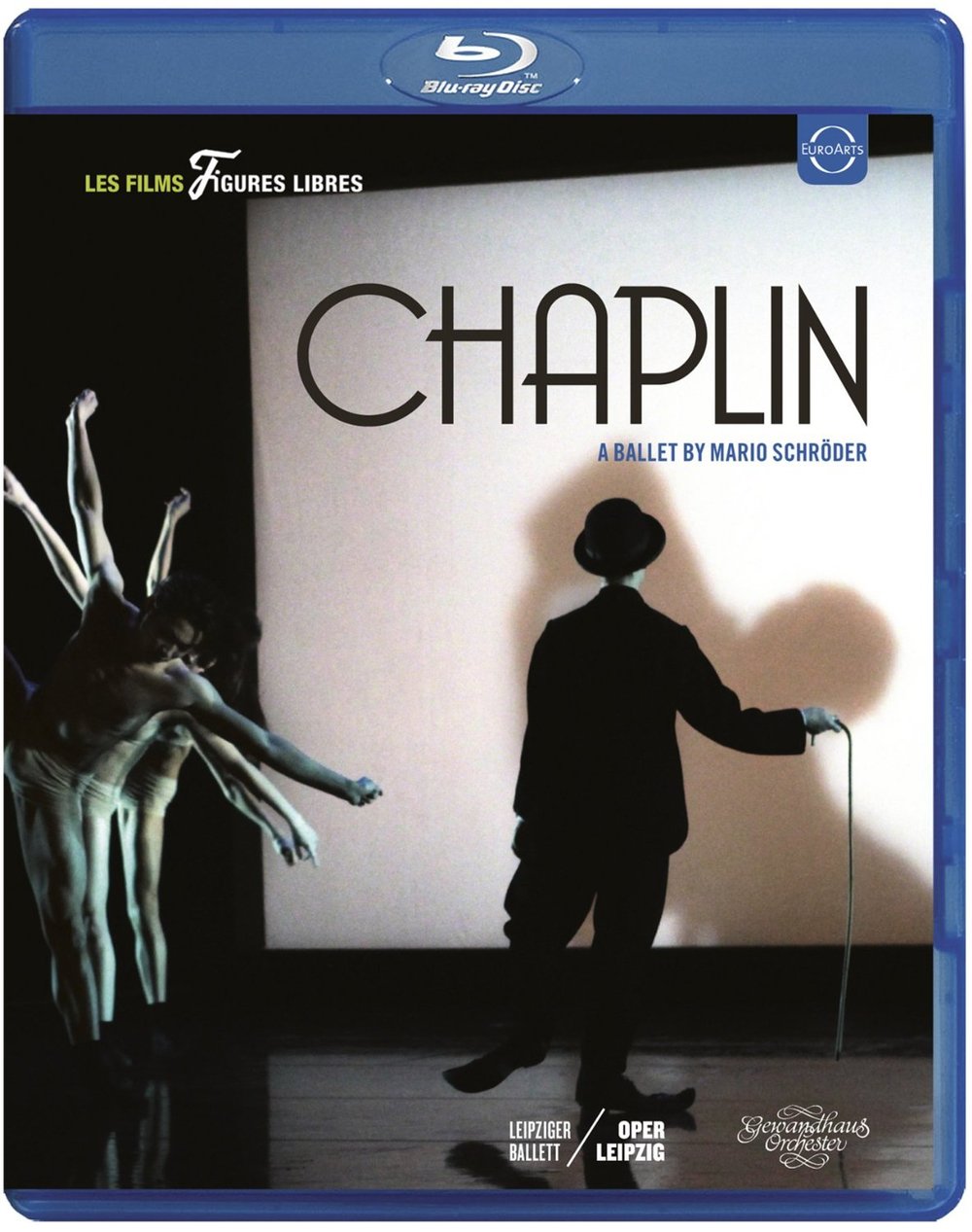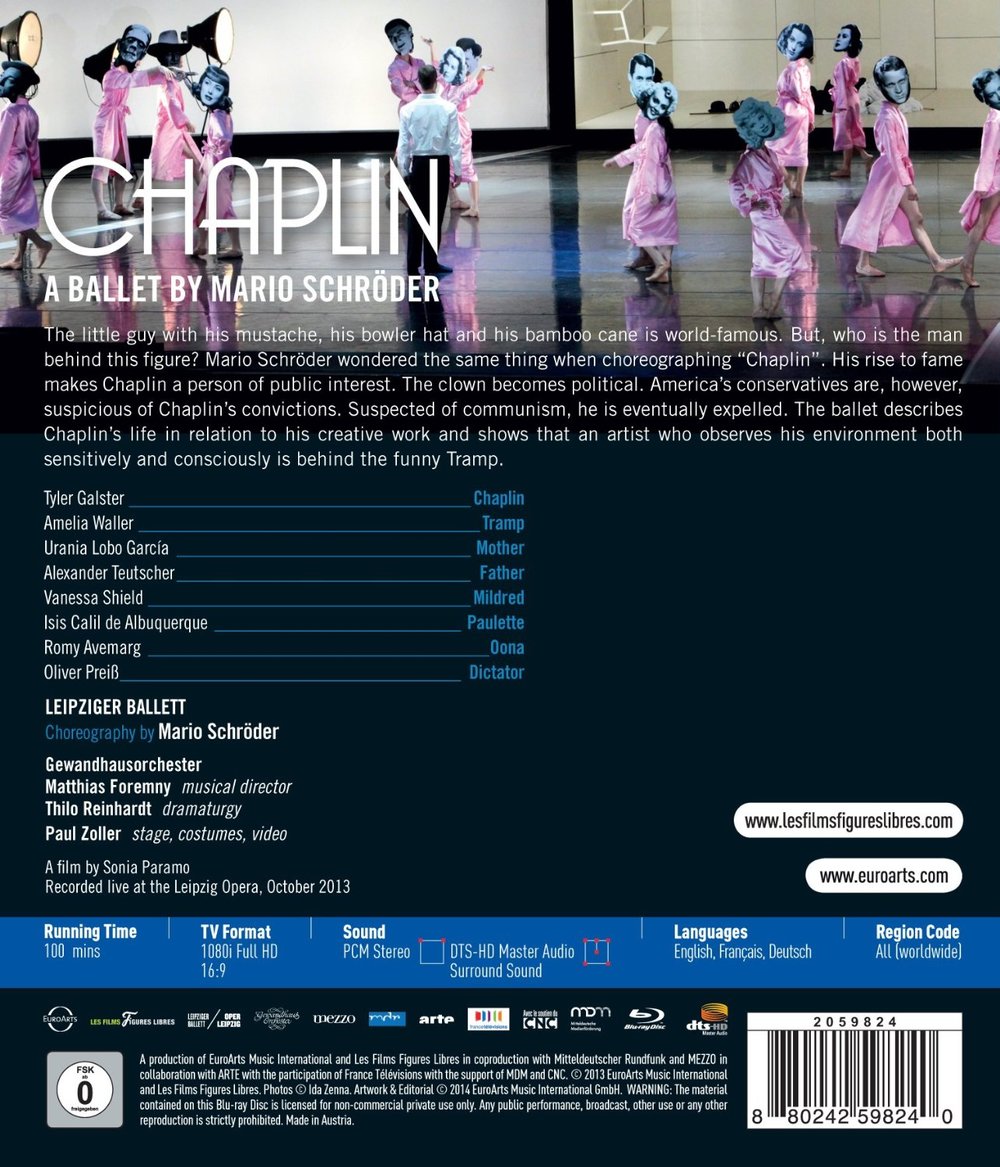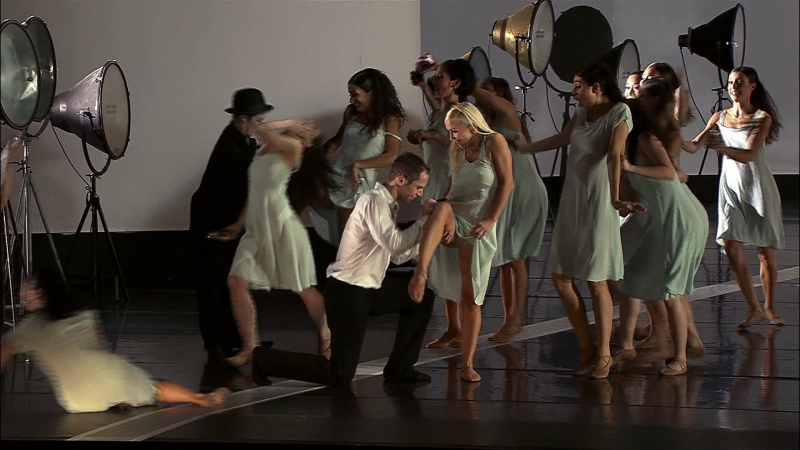

Chaplin ballet firm choreographed and directed 2013 by Mario Schröder at the Leipzig Opera Ballet to music from various composers (including Chaplin himself). Stars Tyler Galster (Chaplin), Amelia Waller (Tramp), Urania Lobo García (Mother), Alexander Teutscher (Father), Vanessa Shield (Mildred), Isis Calil de Albuquerque (Paulette), Romy Avemarg (Oona), Oliver Preiß (Dictator) and the following dancers of the Leipzig Ballet: Laura Costa Chaud, Naiara de Matos, Eveline Drummen, Anna Jo, Fang Yi Liu, Eva Lombardo, Frieda Mennen, Anastasia Paschali, Madoka Sasaki, Tina Slabon, Bjarte Emil Wedervang Bruland, Illia Bukharov, Jake Burden, Ronan dos Santos Clemente, Mark Geilings, Bogdan Muresan, Kiyonobu Negishi, Robert Phillips, Vadim Rzaev, Piran Scott, Takeru Shimizu, Lou Thabart, and Nikolaus Tudorin. Matthias Foremny directs the Gewandhausorchester. Dramaturgy by Thilo Reinhardt; stage sets, costumes, and video by Paul Zoller. Directed for film by Sonia Paramo. Released 2014, disc has 5.1 dts-HD Master Audio sound. Grade: B+
This ballet is not a comedy or a biography. It's a serious piece about the astonishing life of a genius who discovered how to get to just the right place at just the right time. Mario Schröder makes many references to things that were funny and still are funny when you see the old Chaplin movies. But I don't recall laughing even once during the ballet Chaplin. In the opening of Chaplin you do get a bit of factual information. But ballet and biography don't mix well. A ballet can't convey the details of a multitude of specific facts that make up a biography. Ballet can well convey situations, emotions, and personalities. So Chaplin focuses on these kinds of fuzzy concepts and is not much concerned with historical accuracy.
Before we get into the libretto, I'll say a few words about the music. There are 19 dance chapters on the disc. Each has different music, including 5 segments composed by Chaplin himself. Some of the selections are played complete; others are excerpts. Here's the playlist with each dance chapter numbered as on the disc:
[2] John Adams: "Lollapalooza"
[3] Ruggero Leoncavallo: "Prologue" to Pagliacci
[4] Alfred Schnittke: "Postludio" to Concerto Grosso No. 1
[5] Kurt Schwertsik:"With Giant Boots"
[6] Peteris Vasks: Symphony for Strings "Voices of Silence"
[7] Charles Chaplin: Modern Times Suite for Orchestra
[8] Colin Matthews: Fourth Sonata
[9] Charles Chaplin: Lunchtime music
[10] Charles Chaplin "Gold Rush Waltz"
[11] Johannes Brahms: Hungarian Dances
[12] Charles Chaplin: Blind Flower Girl music
[13] Charles Chaplin: "Smile" (Yes, this is the one that Nat King Cole so famously covered.)
[14] Hans Werner Henze: Symphony No. 2
[15] Charles Ives: The Housatonic at Stockbridge
[16] John Adams: "The Chairman Dances" from Nixon in China
[17] Timpani and Percussion Solo
[18] Richard Wagner: Lohengrin "Overture"
[19] Benjamin Britten: "Storm"
[20] Samuel Barber: Adagio for Strings
The Gewandhausorchester played this straight through without pause or intermission — a formidable number of transitions among many musical styles. At the end, conductor Matthias Foremny looked like he had just finished playing his first rugby match dressed in white tie. The music always sounds close, clear, and crisp in an exceptionally good recording.
In the mugshot below, meet the Australian Amelia Waller, who (after a long session in the make-up room) plays the role of the Tramp, Charlie's self-created alter ego:
Many Chaplin films ended with the little Tramp walking toward the horizon, ready for the next chapter in his life. Little went well for him, except he always managed to keep his skin and his dignity. In the first full screenshot below, the Tramp is walking toward a grand adventure indeed — the life of Charlie Chaplin.
Charlie's parents were British entertainers. His dad was an alcoholic who drank himself to death, at age 38, when Charlie was 11. Here behind the screen you see young Charlie sitting on the floor watching his dad beat his mom. But this time mom defends herself well by kicking dad in a soft spot:
While the Tramp heads towards his new life with Charlie, the ballet corps dances sophisticated honky-tonk in the streets. Somebody drops some money, which leads to a brawl:
In the next mugshot we meet Charlie's mom, played by Columbian Urania Lobo García. I'm showing you these mugshots of dancers so you can see how young they are. In opera, you have the problem of 55-year old women playing the roles of teen-age girls. In ballet, it's the other way around with dancers who are too young to rent a car playing the roles of people like Adolf Hitler. No problem for Urania — with her acting skills, she probably could play Methusalem:
Charlies' mom was a singer and dancer. After her husband died, she could not take care of her family and she started to lose her mind. Twice she suffered the horror of having to place her young boys (Charlie and his half-brother Sydney) in shelters for destitute children. When Charlie was 16, his mom was permanently institutionalized. In Schröder's libretto, you get the impression that Charlie was a little kid in short pants when mom died, which is not correct. Let's just say that Charlie had an impoverished and harrowing childhood:
The next mug is Tyler Galster, an American, who plays Charlie. After his mom's institutionalization, Charlie survived by working in theaters and sleeping wherever he could find a dry place. His talent for physical comedy was apparent early and he worked his way up until he was hired to tour the U.S. with a British comedy show. On tour he discovered the fledgling movie industry. As soon as he finished his stage contract, he headed for California and invented the little Tramp character:
The early movies, short and silent, at first took about a week to make. Charlie's well-honed talent for slapstick and pantomime made him an instant success. With his aggressive survival instinct and drive for perfection, he quickly became a leading director. The ballet number below has references to various movies including this depiction of a famous shaving scene from The Dictator:
Charlie soon was world famous. He could make a pretty teenage girl into a starlet almost overnight, so a lot of girls hit on him. Here's Vanessa Shield playing Mildred, who used a false claim of pregnancy to manoeuvre Charlie into a marriage that lasted about 2 years:
And here's a scene commenting on the pleasures and pains of fame — hot action with the fans and dismay at hot reports in the press:
Charlie made about 70 movies. The most famous is probably Modern Times. The longest scene in the ballet celebrates Modern Times with extensive dancing by the full corps to the John Adams "The Chairman Dances" music from Nixon in China:
Out of the corps Paulette appears played by Isis Calil de Albuquerque from Brazil. You get the impression from the ballet that Charlie met Paulette while Modern Times was being filmed. But Paulette Goddard was in fact the leading lady and co-star of Modern Times. She later became Charlie's 3rd wife, but that marriage led to a divorce in a few years:
Even while Modern Times was being made, talking movies were becoming popular. This was the beginning of the end for the little Tramp. For the short time that all movies were silent, Charlie, with his special acting skills could relate directly and with equal effectiveness to just about everybody on earth who had opportunity to see movies. But if the Tramp had to speak, this universality would evaporate---the Tramp would be speaking English with (I think) a British working-class accent. His market would shrink from the universe to the British working class.
But Charlie did make one famous movie where he spoke, The Dictator. By then Charlie was deeply interested in social and political issues. More than perhaps any other person in entertainment, he saw the danger presented by the rise of Adolf Hitler in Germany. Charlie created the character of Adanoid Hinkler, a broad spoof of Hitler. Most of Charlie's gags in The Dictator were delivered silently, but he did speak using made-up German-sounding gibberish to mock Hitler's oratory style. In the ballet, Hitler, or rather Hinkler, is played by the German Oliver Preiß:
Even when Charlie's movie career was winding down, life continued to get stranger for him. An anti-Communist witch-hunt broke out in Hollywood and Charlie was targeted. There was no way he could be accused of disloyalty because he was not a U.S. citizen. Nor did he know anything about military matters or nuclear science. Still, perhaps because of all the young girls in his past, the Prince of Prudes himself, J. Edgar Hoover of the FBI, thought the U. S. would be safer without Charlie. Rather than put up with too much of this, Charlie moved to Switzerland where he could relax and manage his investments. In the next screenshot, we see the little Tramp painted with a hammer and sickle:
In the last few minutes of the ballet, we meet the German Romy Avemarg playing Oona O'Neill, who became Charlie's 4th wife. Oona was the daughter of the famous American playwright and intellectual Eugene O'Neill. When they married, Charlie was 54 and Oona had just turned 18. What were the prospects for this union of a much older man with 3 divorces behind him and yet another minor girl? Divorce lawyers would tell you nil to zero. But Charlie finally had it figured out. The marriage lasted 24 years until Charlie's death when he was 77 and Oona was 42. Together they had 8 children! But along with the glamour and bliss, there was also much Bitter. Oona's father, author of famous tragedies, denounced Oona for marrying for money, disinherited her and all her progeny, and refused all reconciliation. Oona became an alcoholic. In her old age, she secluded herself in her Swiss palace, a besotted Queen surrounded by a glittering salon of friends and companions dressed as bottles and glasses.
I pointed out earlier that this ballet is neither a comedy nor a biography. I think it's best called an homage to Chaplin. This is explained by the choreographer himself who makes a brief special appearance in the film to explain what Charlie's life was and still is about:
It's impressive how much Mario Schröder was able to accomplish with his small forces at the Leipzig Opera Ballet. His group is only a fraction of the size of the national companies (like the Bolshoi with over 200 dancers) that provide us with most of our ballet HDVDs. It's just half the size of the Berliner Staatsballett and also smaller than the Hamburg Ballet. The Leipzig Ballet is astonishingly young and cosmopolitan with its 40 dancers coming from 25 countries. Yet Schröder was able to write and perform a completely original work good enough to get published by EuroArts, and that without spending money on famous guest dancers.
How did Schröder do this? First he got full support from the orchestra that allowed him to serve up high-quality live music that probably has rarely or never been used before in a ballet. He then wrote a libretto to his strengths with lots of action dancing, stagecraft, and character acting to keep things interesting. Since there is no grand romance in this libretto, he didn't need a magnificent pas de deux. Then he got his dancers together and said, "I'm going to produce a new, world-class, story ballet about the greatest comedian and movie director in history, and you guys are going to it with no outside help. You 40 guys are going to make this the biggest splash since Alibaba recruited the 40 thieves!
And they do. (Well, maybe they had some help from that acrobat.) Schröder has 8 dancers in house who are terrific in the acting roles. He commits his entire corps over and over again in the action scenes. Galster and Waller stay on stage as Charlie and the Tramp most of the time. The other credited dancers appear briefly in their acting roles and then go right back to the corps to continue dancing their butts off. It's amazing how much you can get from 40 youngsters if you let them do it all.
And I can see how this Chaplin ballet probably had a powerful appeal to Schröder's platoon. Chaplin appealed to everybody in the world with an art form that didn't use words. And that's what dancers also do. Chaplin moved wherever he needed in the world to make things happen. And that's what most of Schröder's dancers have done. Chaplin was prepared for his right time and place. And that's what all of Schröder's kids are working towards.
Time for a grade. I had trouble with this title the first time I saw it. I didn't know enough about the life of Charlie Chaplin to follow the piece. This review ought to help you a lot with this. I also suggest you read up a bit on Chaplin on the Internet. Because the libretto is not self-explanatory, I think the correct grade for this title is a "B," which I bump up to "B+" on account of the tremendous energy of the cast. But for viewers who are Chaplin fans, this would be an "A" title.
Sorry, there was an EuroArts trailer, but it got into copyright trouble.
OR



























